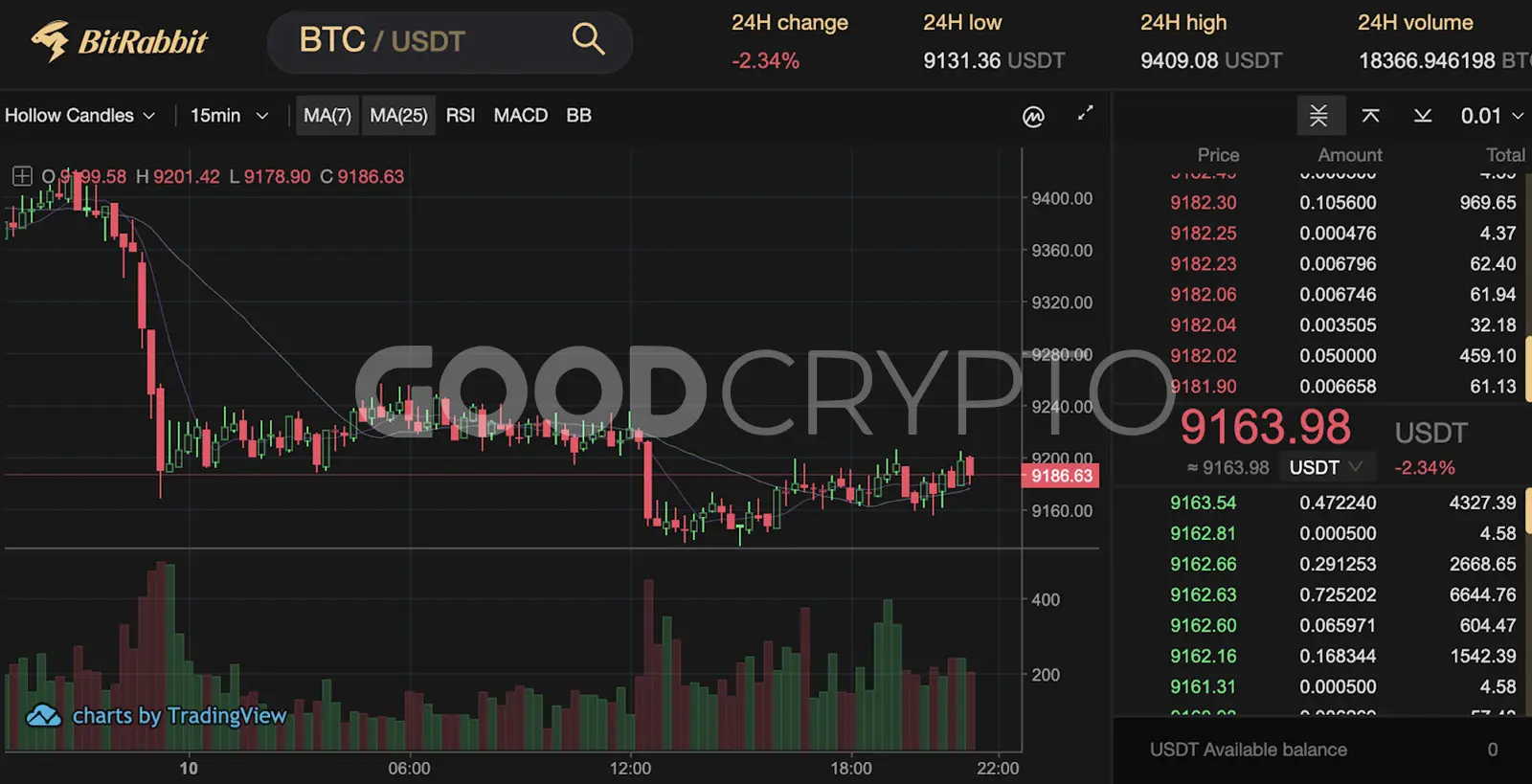Bitcoin is digital gold. Users all over the world make fast, safe, and cheap transactions without the intervention of centralized authorities using BTC. Trad...
Get the App. Get started.

Liquidity is a topic that always pops up now and then in both the crypto community and beyond. We are sure that there is no crypto enthusiast who hasn't heard about Bitcoin liquidity. The question is how to calculate liquidity and how to find the most liquid exchange? Let’s dig out the truth, but first things first.
Liquidity is a key parameter of a certain market, which reflects the “saleability” of a certain asset. Making it simple - liquidity reflects the price change, which will be caused by filling the Market order of a certain size. In a perfectly liquid market, one would be able to sell any amount of an asset at the same price without moving it.
Thus, liquidity is an opportunity to sell assets on the market without influencing their price. Liquidity could be measured not only for certain assets but also for the whole market in general. Let's dig deeper and determine how liquidity affects crypto trading with and what you should know about it.
The liquidity of a cryptocurrency is determined by a number of factors - from its popularity to real-world use cases of the traded asset. To better understand the concept of liquidity, it’s crucial to introduce the Order Book of a certain market. The name says it all - order book is a list of other people’s confirmed desire to purchase a traded asset at a certain limit price. When someone needs to buy or sell the crypto-asset immediately, they will have to place Market orders, which will execute against the available orders in the order book.
For example, someone plans to Buy or Sell 1 BTC having an appropriate amount of USDT and BTC on balance. Let’s review some of the options to do this (it’s worth mentioning that at the time of writing, BTC is worth something around $9,200).
First, let’s look at BTC/USDT pair on the Binance exchange.

In the right section of the trading interface, you can see the above-mentioned order book and the last price at which BTC was bought or sold. From the order book, we can see that the lowest price at which someone is ready to Sell BTC is 9,189.04 and there is 4.026387 BTC available at this price.
If the user will submit a Market Buy order at the moment of the screenshot, her order will be matched against that offer and the last price of BTC/USDT would become $9,189.84, the amount of BTC available at this price will decrease and become 3.206387 BTC. In this case, liquidity on a Binance BTC/USDT pair on the Buy-side was good enough for a 1 BTC order size allowing the trader to Buy the BTC at the best available price.
At the same time, we can see from the other side of the order book that the highest price at which someone is willing to Buy BTC is 9,189.83, but they are willing to buy only 0.693640 BTC at this price. Consequently, if the user submits a Market Sell order for 1 BTC, he will ‘eat’ through 3 levels of the order book. Such an order will consume entire Buy offers at 9,189.83 and 9,189.71 levels and most of the 9,189.47 price level, moving BTC/USDT price to $9,189.47. At the same time, the All Buy orders sitting in the Order Book with the prices of $9,189.83 and $9,189.71 would be 100% filled, while the Buy orders with the price of $9,189.47 would be partially filled for the size of 0.30136 BTC. The average execution price of the 1 BTC Market Sell would be:
0.69364*9,189.83 + 0.005*9,189.71 + 0.30136*9,189.47 = $9,189.72. The difference of $0.11 between the observed best Buy offer in the Order Book at 9,189.83 and effectively achieved the average execution price of 9,189.72is called price slippage. Price slippage represents a loss for the trader due to insufficient liquidity on the Buy side of the Binance order book. Were the trader to send a Market Sell order for the amount greater than 1 BTC, the price slippage incurred would increase substantially.
Besides the direct price slippage implications of exchange order book liquidity, one could also try to derive various trading signals from it. In the example above, since the liquidity of BTC/USDT pair on Binance appears to be better on the Sell-side of the order book, a simple conclusion could be drawn that the Selling pressure is high and that high Level 1 Sell liquidity represents market makers’ opinion that the short-term market price movement will be downwards. However, since this prediction is quite obvious, it might not come to fruition.
Binance, though, isn’t the only exchange on the market. Let’s check what would happen if the same user would try to complete the same orders on let-it-be BitRabbit exchange. Frankly speaking, we’ve never heard of this exchange and strongly don’t recommend using it for trading. One of the reasons, apart from the funny name and doubtful security of the exchange, would be presented below.
On a screenshot, you can see the same market (BTC/USDT) on the BitRabbit exchange. The first notable difference is that the price of BitRabbit is around $30 lower than on Binance. Though, it’s not the biggest problem with this screenshot.

If the user will (for any reason) deposit the necessary funds to purchase and sell 1 BTC worth of assets - the situation will be different compared to Binance.
If she will try to submit a Market Buy of 1 BTC for USDT the order will be executed at the price that is nowhere near the Last Price of $9,163.98. The thing is that all the Sell orders sitting in the whole visible part of the order book aren’t enough to fill the order of 1 BTC. Even more, they won’t even fill a third of it, which means that the average price of 1 BTC purchased on this exchange at Market would be over $9,182, representing a price slippage of almost $20. Remember, that on Binance the price slippage incurred by the same 1 BTC order was just $0.11.
In the case of Market Sell Order of 1 BTC on BitRabbit, the slippage would not be so bad, though the order will ‘eat’ through the first three levels of the order books and fill at fourth - the price will slip less than a dollar.
This simple comparison gives you a basic idea of why liquidity is such an important characteristic of an exchange. If an order of 1 BTC can create a slippage of 20+ dollars, imagine what would happen next time BTC rallies some $500+ in 15 minutes and you are trying to exit or enter a large position on an exchange like BitRabbit.
Exchange listings.
The asset’s presence on several trading platforms increases its liquidity in most cases. The more exchanges have listed an asset, the more opportunities for traders to trade it. So, the trade volume is increasing.
Though, often, listings don't provide liquidity. It is a typical situation when one of the assets in TOP 50-150 of CoinMarketCap is listed on 10 exchanges, while it has more than $100,000 daily volume only on 1-2 of them.
Though, in general, new cryptocurrencies are characterized by low liquidity due to their absence from major exchanges.
Use cases outside the crypto industry.
A holy grail of every crypto project is wide user adoption though, real adoption was achieved only by a few of the coins on the market. Apart from the obvious BTC use case as a “digital gold” and store of value, Ethereum managed to get some real usage back in 2017, when a boom of Smart Contracts and ICOs occurred. It now seems to gain traction with DeFi.The most recent example of wide enough adoption is Binance Coin, which became a lottery ticket to the IEO hype of 2019. Though, both of these cases still weren’t a “wide adoption outside of the crypto industry” - more like wide adoption inside of it.
Popularization.
The stronger the crypto community scales, the more liquid in general the crypto assets are. This fact is undeniable and the proof is the performance of Bitcoin in 2017, when this coin rapidly gained at price, volume, social media mentions, and Google trends.
However, if the cryptocurrency is new and a sufficient number of crypto enthusiasts haven’t heard about it, then, most certainly, it lacks trust from the crypto community. The asset would be considered of low liquidity or, in the worst case, manipulated by bot trading and fake market making. At the same time, the asset has every chance to change its position, drawing attention to it with marketing activities, constant development, and a solid project team behind the project.
The liquidity of cryptocurrencies is undoubtedly an important parameter that you should pay attention to when devising your trading strategy.
Think about buying a $10,000 worth of some TOP-500 altcoin, while it’s daily trading volume is $20,000. In the best case, if you don’t want to push the price up to and incur huge slippage, you’d have to accumulate your position over a week or even a few weeks. Illiquid assets often become subjects of speculations, and pump and dump schemes. It is easier for pumpers to influence the price of an illiquid asset by buying or selling a large chunk of the daily volume of this asset. In case, if the asset has low liquidity, this “large chunk” of daily volume would cost the pumpers less money.
Sadly, Pump and Dump schemes are still a thing in the crypto market. As a result, the vast majority of the new crypto traders fall victims to at least one of those schemes. Mainly, if a new crypto enthusiast goes through an experience like this, basically a new crypto market hater would go to social media and spread the word that the whole industry is a fraud.
One notable thing about crypto markets and industry, in general, is that despite the speculative spikes, one could see a slow but steady adoption. It is reflected not only in the real-world use cases, a growing number of wallets, and on-chain transactions but also in the growing liquidity of the crypto market in general. It can be seen when looking at the crypto trading volume on major exchanges 2020 volumes are much higher than in 2017 or 2018 when BTC was all over the news with an all-time high price of $18,000-$20,000.
Though undeniably growing in general, crypto liquidity is shifting. Some of these shifts represent secular trends such as growing liquidity of derivative and margin exchanges vs the spot exchanges, and some are cyclical, such as periodic shifts from BTC to altcoins (altseason) and back, or the evergreen ‘flippening’ of BTC and ETH.
Share this post:
September 11, 2020